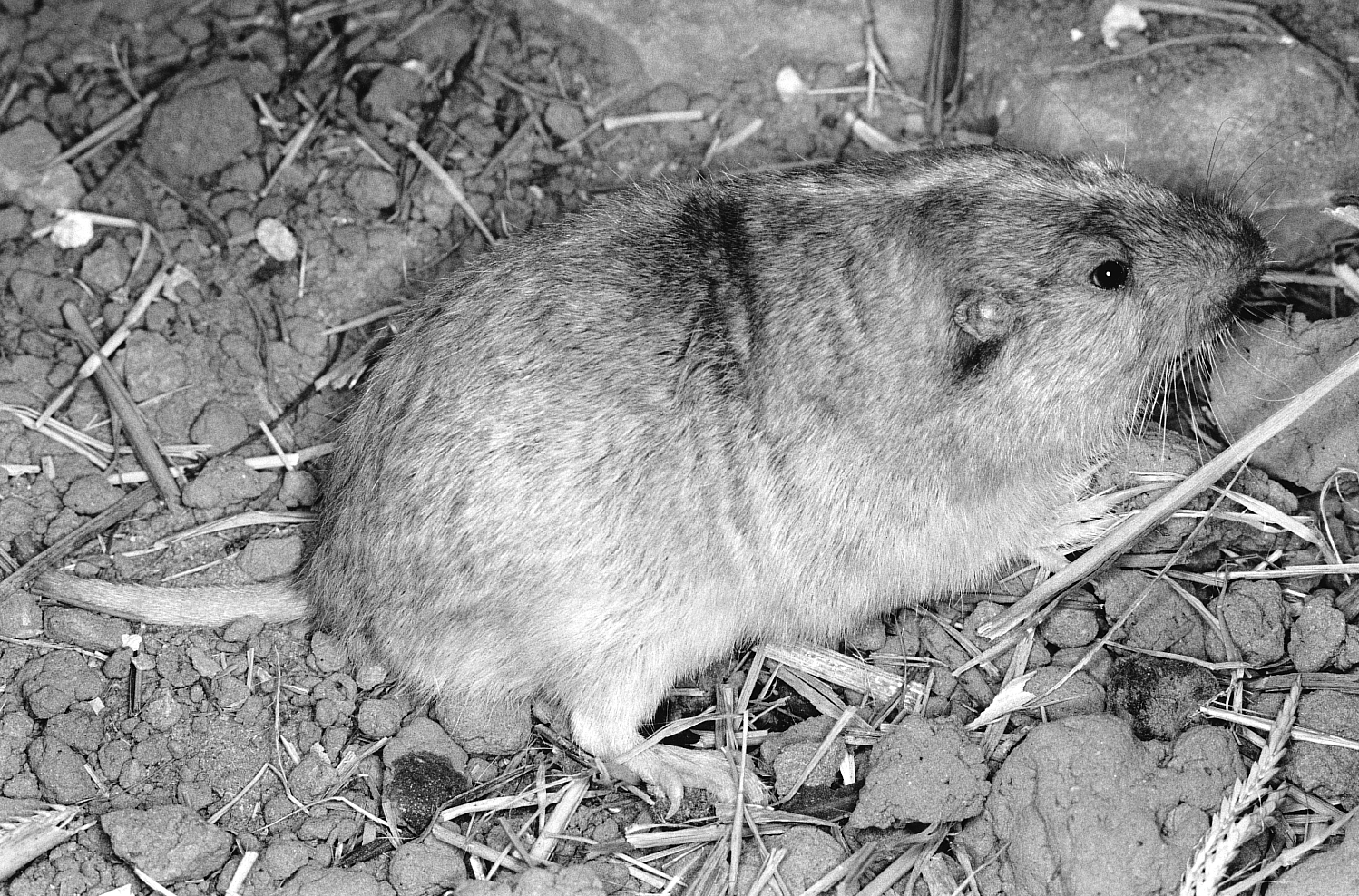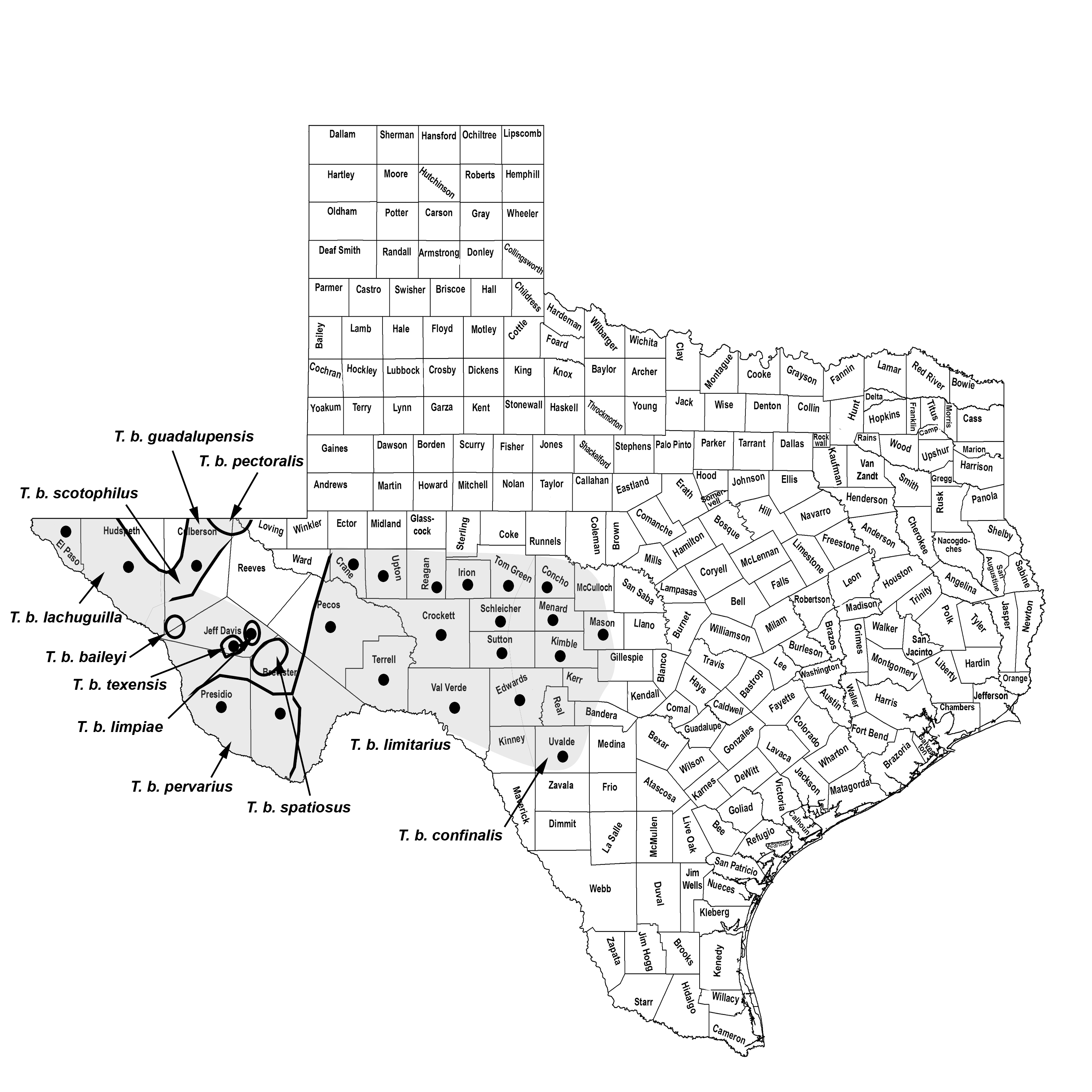BOTTA'S POCKET GOPHER
Thomomys bottae (Eydoux and Gervais 1836)
Order Rodentia : Family Geomyidae
DESCRIPTION. A medium-sized rodent with external, fur-lined cheek pouches; the outer face of the upper incisors lacks conspicuous grooves; claws on front feet relatively small (<10 mm long); upperparts varying from pale gray to russet and blackish; underparts grayish white, white, buffy, or mottled. Dental formula: I 1/1, C 0/0, Pm 1/1, M 3/3 × 2 = 20. External measurements averages: males, total length, 267 mm; tail, 81 mm; hind foot, 33 mm; females, 219-69-28 mm. Weight of males, 160–250 g; of females, 120–200 g.

DISTRIBUTION. Trans-Pecos Texas and eastward across the Edwards Plateau and immediately adjacent areas to Mason County.

SUBSPECIES. Ten subspecies are recognized in the state. The following eight are all restricted to suitable habitats in the Trans-Pecos region: T. b. baileyi, T. b. guadalupensis, T. b. lachuguilla, T. b. limpiae, T. b. pervarius, T. b. scotophilus, T. b. spatiosus, and T. b. texensis. Additionally, T. b. limitaris occurs in the eastern Trans-Pecos and eastward across the Pecos River onto the western part of the Edwards Plateau, and T. b. confinalis occupies parts of the Edwards Plateau to the east. However, in 2005, Wickliffe, Baker, DJS, RDB, and others demonstrated exceptionally low levels of genetic divergence among subspecies and implied that the subspecies may not be warranted.
HABITS. Botta's pocket gophers are extremely adaptable as regards habitat. They occur in soils ranging from loose sands and silts to tight clays and in vegetative zones grading from dry deserts to montane meadows. Perhaps one reason they can tolerate such environmental extremes is that they spend fully 90% of their lives in underground burrows.
Their burrow systems are often complicated structures consisting of more than two main galleries and several side chambers. A partly excavated burrow extended >30 m (98 ft.) in length, had four main forks, and averaged 6 cm beneath the surface, although the tunnel leading to the nest descended to a depth of >60 cm. Tunnel systems >150 m (492 ft.) in length are not rare. These tunnels probably help the occupants avoid predators; they are equally important in permitting the pocket gopher to forage over a considerable area without exposing itself to aboveground predators. Special side branches serve as storehouses for food, others as repositories for refuse and fecal pellets. In winter, when snow covers the ground, the gophers often extend their burrows into the snow and can then forage aboveground in safety.
Although pocket gophers are active year-round, they store food to carry them over periods of scarcity, especially periods of drought when food is scarce and burrowing is difficult. Usually, only one adult animal occupies each burrow system, except for a short time in the breeding period. Associated with this solitary habit is a ferocious and seemingly fearless disposition. When two gophers encounter each other, they either fight or meticulously avoid each other.
Botta's pocket gophers feed on a variety of foods, but fleshy roots and tubers are the main items. Unlike G. bursarius, Botta's pocket gophers often come to the surface to feed and clip off vegetation around the burrow as far as they can reach in all directions without losing physical contact with the opening. If disturbed, the animals back into the burrows with amazing speed. At other times, they approach desirable plants from below and pull the entire upperparts into the burrow, where they can be cut up and stored or eaten at leisure. The roots of alfalfa are especially prized, but almost any native plant is potential food.
The nest is a compact, hollow ball of dry, shredded vegetation placed in a special chamber off the main gallery, about 30–70 cm beneath the surface of the ground. Both sexes build nests as sleeping quarters.
This species breeds continuously, with three marked periods of increased fertility in spring, summer, and early winter. The primary breeding season is in spring, however; summer breeding is mainly by young females, possibly those born the preceding spring. The winter season is one of slight breeding activity and often merges with the one in early spring. Old females produce yearly an average of two litters of five young each; young females are less fecund. The young are blind, naked, unpigmented, and weigh about 4 g at birth. The ears are poorly developed, but the cheek pouches are fully formed, although smaller than in adults. Growth appears to be relatively slow, but details of this phase of their life history are lacking.
In cultivated areas, pocket gophers may be destructive and require control by trapping or poisoning. However, on natural lands they are of decided benefit due to their aeration of soils.
POPULATION STATUS. Common. This species is thought to be locally abundant, although some of the montane subspecies may have disappeared.
CONSERVATION STATUS. The IUCN lists Botta's pocket gopher as a species of least concern, and it does not appear on the federal or state lists of concerned species. There is some indication that this species may be losing ground to a competitor, Cratogeomys castanops, in western Texas as a result of climate changes involving increased aridity. At least two subspecies, T. b. baileyi from Sierra Blanca in Hudspeth County and T. b. limpiae from near Fort Davis in Jeff Davis County, are now thought to be extinct in Texas. Populations from the Big Bend area that are not in proximity to C. castanops appear to be holding their own.
From The Mammals of Texas, Seventh Edition by David J. Schmidly and Robert D. Bradley, copyright © 1994, 2004, 2016. Courtesy of the University of Texas Press.
Natural Science Research Laboratory
-
Address
Museum of Texas Tech University, 3301 4th street, Lubbock, TX 79409 -
Phone
806.742.2486 -
Email
nsrl.museum@ttu.edu

